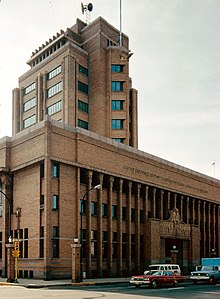Prairie Houses


The Prairie Houses are buildings of an architectural style, which in the late 19th century and early 20th century in the Midwest of the United States established. Alongside the Adobe architecture of the Southwest , the Prairie style is the first residential style in post-colonial American architectural history to consistently dispense with stylistic borrowings from European architecture. Unlike the Adobe style, however, it has not found its way into the architectural mainstream.
Several architects (including Frank Lloyd Wright , the married couple Marion Mahony and Walter Burley Griffin or Alfred Caldwell ) can be combined to form the so-called "Prairie School". The associated architects are each connected to Louis Sullivan , who himself is not part of the "Prairie School". The term was only coined in retrospect by the architectural historian H. Allen Brooks.
The buildings designed by these architects are characterized by horizontal lines. This corresponds to the fact that the windows were arranged in horizontal rows. The roofs were designed as flat or hipped roofs with protruding eaves . The aim was to achieve a high degree of integration of the buildings into the landscape - especially the typical landscape of the Midwest: the endless prairie .
Frank Lloyd Wright elevated this form of architecture to the concept of the “Prairie Style”, which is characterized by open room design, horizontal alignment and the use of natural materials. The concept is related to the Arts and Crafts Movement , which preferred manual work to industrial production and placed emphasis on simplicity and functionality. In doing so, it came into opposition to the predominant neoclassical architecture of the time. This concept is to be understood in connection with the intellectual currents of American Romanticism (e.g. Walt Whitman ) and Classical Modernism (e.g. Bauhaus ). Wright's most famous Prairie House is the Frederick C. Robie House in Chicago (1909/1910), his last and most lavish was the Herbert F. Johnson House ("Wingspread") built in 1938–1939 in Wind Point , Wisconsin.
See also
literature
- John C. Poppeliers, S. Allen Chambers: What Style Is It? A Guide to American Architecture. Improved edition. John Wiley & Sons, New York 2003, ISBN 978-0-471-25036-4 , pp. 110-114 (= Prairie Style ).
Single receipts
- ^ Brooks, H. Allen: Prairie School Architecture: Studies from "The Western Architect" . Toronto 1975, ISBN 978-0-8020-2138-0 .
